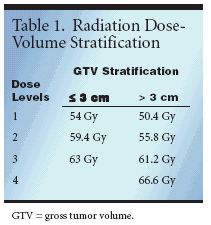Dose-Escalated IMRT Plus Chemo Studied in Locally Advanced Cervical Cancer
The 14 reports in this special supplement discuss theuse of the cytoprotectant amifostine in patients withcancer of the head and neck, esophagus, lung, andcervix, as well as those with lymphoma and acutemyelogenous leukemia. Discussions focus on thepotential of this agent to both reduce radiation sideeffects such as xerostomia and permit doseescalation of chemotherapy and/or radiotherapy.Improvements in treatment outcome and quality oflife as a result of cytoprotection are examined.
BIRMINGHAM, AL-Paraaorticlymph node metastases are aparticularly bad finding in cervicalcancer, predicting extrapelvic relapse,more rapid progression, anda shorter survival duration. Combined-modality chemotherapyplus radiation improves outcomes,but radiation is dose-limiting becausemany vulnerable organs arelocated in the target area.Jennifer F. De Los Santos, MD,and colleagues will attempt to overcomethe dose-limitation problemin a phase I trial of dose-escalatedintensity-modulated radiationtherapy (IMRT) plus cisplatin(Platinol), coupled with amifostine(Ethyol) cytoprotection, inpatients with intact cervical carcinomaand positive para-aorticnodes. Dr. De Los Santos, an assistantprofessor of radiation oncologyat the University of Alabama,Birmingham, noted that theplanned study will include researchersnot only from her owninstitution but also from the Universityof Chicago, the Fox ChaseCancer Center, and the Universityof Oklahoma.GI Toxicity Historically High
"The 4-year overall survival ofpatients with carcinoma of theuterine cervix and involved paraaorticlymph nodes is 30%," Dr.De Los Santos said. "The RadiationTherapy Oncology Group[RTOG] 92-10 trial investigateddose-escalation with hyperfractionatedradiotherapy but reportedunacceptable acute and late toxicities,notably 50% grade 4 acutegastrointestinal [GI] toxicity and acumulative incidence of late grade3 and grade 4 toxicities of 34% at36 months."

Several trials have shown that itis possible to set IMRT to deliverdoses as high as 50.4 Gy to thepara-aortic nodes while sparing thesmall bowel and rectum. Dr. DeLos Santos also said that researchin Japan recently documented thefeasibility of delivering dynamicarc conformal therapy, a simpleform of IMRT, in 29 patients withisolated para-aortic nodal recurrences,to doses of 50 to 63.4 Gy(median, 60 Gy).[1] "Two-year infieldrecurrence-free survival was58%, with acute grade 1 and 2 GItoxicities occurring in 31% and17% of patients, respectively.There were no grade 3 complications,either acute or late," shereported.Adding Cytoprotection
Because amifostine has beenassociated with a reduction in acutegrade 2 or 3 bladder and lower GItract toxicities in patients beingtreated with definitive or postoperativeradiation for pelvic malignancies,Dr. De Los Santos andcolleagues decided to test this cytoprotectivedrug with IMRT incervical cancer patients who hadpara-aortic metastases."The primary objective will beto determine the maximum tolerateddose of external-beam radiationtherapy [EBRT] to the paraaorticnodes when using IMRT andamifostine. Secondary endpointswill be local-regional control, overallsurvival, and acute and late toxicity,"she said.The trial will enroll patients whohave had no prior therapy otherthan cervix biopsy with or withoutendoscopic resection of enlargedpelvic nodes. They must have positivepara-aortic nodes, defined asnodes at least 1.5 cm or less than1.5 cm that are biopsy- or PETscanpositive, and no other evidenceof distant metastasis.Study Design
Treatment will include EBRT to45 Gy in 25 fractions to pelvic andpara-aortic fields, with concurrentcisplatin at 40 mg/m2/wk for 6weeks. Two low-dose radiation orfive high-dose radiation insertionswill be done over 2 to 2.5 weeks todeliver an equivalent of 85 to 90Gy within 56 days, and parametrialand pelvic nodal boosts will occurin the interval between brachytherapytreatments. IMRTpara-aortic nodal boosts will begiven at the same time as theparametrial/pelvic nodal boosts."Amifostine 500 mg SC will beadministered 30 to 45 minutesprior to each EBRT treatment excepton the days of cisplatin infusion,"Dr. De Los Santos said. "Amifostine500 mg SC will be administeredprior to each dose of platinumchemotherapy."The radiation technique will bea standard four-field box of thepelvis with the isocenter placed atthe L5/S1 interspace, matched to apara-aortic IMRT chimney, shesaid. IMRT fields will treat all microscopicdisease in the para-aorticchain from the T11/12 interspaceto the L5/S1 interspace, anda sequential boost to the involvedpara-aortic nodes with reducedIMRT fields will be delivered at thetime of the parametrial/pelvic nodalboost. The trial is a phase I doseescalationstudy to determine themaximum tolerated dose of radiationin patients treated with IMRTand amifostine. The dose is stratifiedby tumor volume in the paraaorticregion, so that larger volumeswill initially receive slightlylower doses (see Table 1) to avoidoverdosing critical structures (eg,bowel, kidney, spinal cord, etc).
References:
1.
Aoki T, Nagata Y, Mizowaki T, etal: Clinical evaluation of dynamic arcconformal radiotherapy for paraaorticlymph node metastasis. RadiotherOncol 67(1):113-118, 2003.